Today, the growing digital landscape is transforming every aspect of ecommerce businesses.
Innovative technologies and smart data analytics tools have made it easy for small businesses to drive their ecommerce ventures favorably.
But primarily, ecommerce marketing revolves around boosting online traffic and lead conversions. This requires an effective mix of diverse ecommerce marketing strategies.
From steering organic traffic on the website via SEO activities to leveraging Facebook and Google Ads for driving conversions, small-scale eStore faces challenges in rolling the perfect amalgam of ecommerce strategies, channels, and tools.
Thus, to ensure that eCommerce vendors keep a better hold on picking viable ecommerce strategies and channels, GoodFirms surveyed to apprehend the experts’ opinion.
About The Survey
GoodFirms surveyed 100+ specialists from top ecommerce marketing companies to identify which ecommerce marketing strategy works best for small-scale eStores.
The surveyed users were asked to pick the best strategies among the four options - PPC Ads, Content Marketing, Social Media Marketing, and Email Marketing.
Below is a brief overview of the survey which depicts the results based on respondents’ choices.

Detailed Findings
Ecommerce marketing experts say that the process of selling products using an ecommerce platform is not that hard, but employing the right selling approach is difficult.
Thus, to identify the right approach, GoodFirms conducted a survey wherein marketers responded with their most favored eCommerce marketing strategies.
The below graph represents the preferred marketing strategies picked by ecommerce marketers.
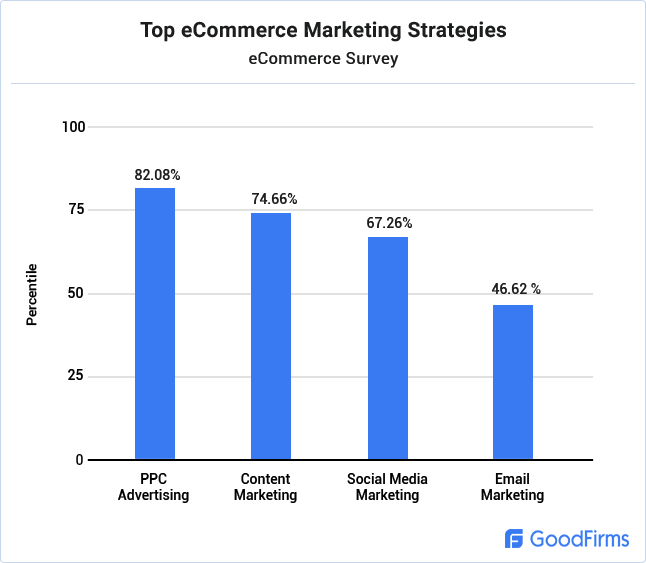
Marketers also asserted that one needs to identify the right combination and permutation from the above four marketing strategies depending upon their business; because finding the perfect blend will definitely do wonders to their eStore.
Like Adrian Cordiner, the Director of Digital Rhinos mentions
Avoid limiting yourself to just one channel because most effective strategy to drive traffic to your store should begin as a combination of SMM, Content Marketing, Email Marketing, Display Advertising, and PPC Ads.
Below are the top ecommerce marketing strategies which marketers employ to drive traffic on their eStores.
PPC Advertising
Pay-Per-Click (PPC) Advertising or Display Ads is a prominent ecommerce marketing strategy to attract consistent traffic on your eStore.
It is a proven state that PPC marketing generates instant results, which are scalable as well as measurable.
Be it the launch of a new product or promotion of existing eCommerce offerings, streaming effective and well-planned PPC campaign results in generating desired sales.
During the survey, Jakub Kliszczak, Marketing Specialist at CrazyCall, contributed his views
PPC Ads should be the core of marketing strategy for any e-commerce venture. They help gain a significant boost in traffic, target the exact audience you'd like to reach, and quickly make sales when you need them.
Therefore, as recommended by the experts, online sellers must roll out PPC campaigns for nurturing their e-business.
How PPC Experts Ensure the Success of Paid Campaigns?
The success of Pay-Per-Click Advertising depends on Ad Ranks and the Quality Score.
Ad Ranks, which commands the position and visibility of the advertisement on SERP, is determined by two things - Quality Score and the Bid Amount.
QS affects the overall performance of the paid ads, and it also decides the price that a store seller pays when someone clicks on the ad.
Seeing the influence of the QS on Ads, PPC managers concentrate upon maximizing the Quality Score metrics. As per Google, QS is a combination of three components-
- Relevancy of the ad to the person who is viewing it.
- Keywords used in the title and description of the paid ad.
- Landing page on which the user arrives after clicking the ad
Therefore to stimulate the ROI, PPC gurus find unbeatable keywords, including long-tail phrases. Using these keywords, they craft creative and relevant ad copy, which helps in improving the click-through rates and enhances the Quality Score.
PPC Campaigns Management Tips from Highly Experienced PPC Experts:
- Define the target segment.
- List down the possible high converting keywords.
- Promote products that are available for direct purchase.
- Design Ads that are engaging enough to be clicked.
- Include lucrative offers in ads to entice the target audience.
- Compose an effective landing page to redirect the audience who click on the ad.
Types of PPC Campaigns
1. Google Shopping Ads
Google Shopping Ads, aka the Product Listing Ads (PLAs), appears on the top of Google search and shopping results.
The paid ads include basic yet essential aspects like product image, product title, its price, reviews, and promotional offers (if available).
PLA Example
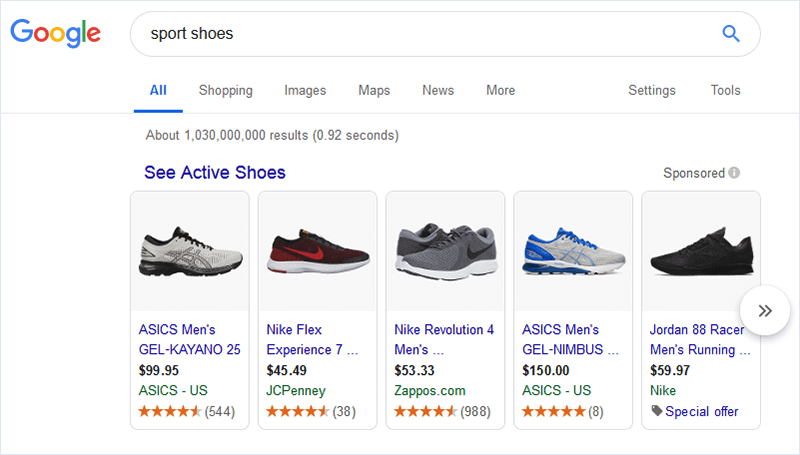
In Shopping Tab
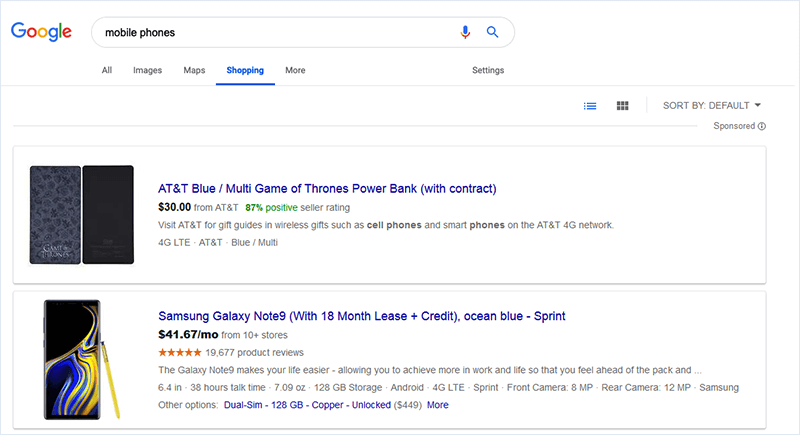
PLAs are highly user-friendly and visually oriented. Thus, it quickly pulls the attention of human eyes and entices them to click on the ad leading to higher conversion rates.
Seb Dean, Managing Director at Imaginaire Digital, shares his experience stating,
We've tended to find that search has the highest level of commercial intent and, generally, can offer the best conversion rates. We watch the average cost per click of the Google Ads and, as a rule of thumb, recommend to start with PPC if the cost per click is cheap enough to allow a volume of traffic.
How to Actualize the True Potential of Google Shopping Ads - Dos and Don’ts?
Dos
- Use original high-quality product images rather than relying on the pictures provided by the manufacturer or any other 3rd party.
- Pick the relevant keywords and include them in titles and descriptions of the ads.
- Optimize the feed content as per the Google specifications.
- Segment your shopping campaigns to precisely reach your target audience.
- Redirect the customer on the desired landing pages and make sure that they find the relevant product along with the essential information.
Don’ts
- Don’t use generic keywords as it will drain the ad budget.
- Do not always redirect visitors on the website homepage as it may increase the bounce rate.
- Do not ignore filtering out negative keywords as they result in poor ad impressions and thus unproductive click-through rates.
2. Display Advertisement
Display ads are prevalent Adword campaigns, which are classified as the visual ads appearing on third-party websites.
The key to display advertising is reaching the right audience at the right time. Hence, display advertisement targets the audience, which is apparently in the midst of something but might have an interest in the product your eCommerce store is offering.
Marketers also prefer display ads for promoting the brand and recalling the potential buyers about the specific product. Thus, retargeting, which is a primary form of behavioral marketing, comes into existence.
Robust retargeting strategies helps marketers in chasing potential customers while they are surfing on the internet.
Display Ad Example
The below example is a display ad on the left corner of a blog post pulling the reader's attention.

When clicked on the Ad, it redirects on a landing page highlighting a clear salable message, well-placed HD product images, enticing gift voucher, and other crucial touchpoints to convert the audience into a lead.
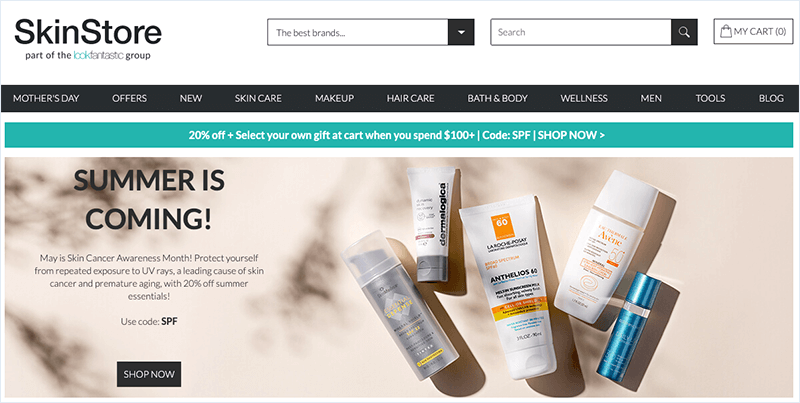
How to Actualize the True Potential of Display Ads - Dos and Don’ts?
Dos
- Plan ad placement on sites with accordance to the demographics as it is the only key to maximize the click-through rates.
- Showcase the product features in the ad to attract potential buyers.
- Use interactive media and long-forms of texts to draw the viewer on your landing page.
- Include a clear call-to-action button.
- Optimize the ads for mobile users.
Don’ts
- Avoid placing ads on over-crowded locations until the sites are authentic.
- Don't redirect the user on the landing page wherein they can’t find the advertised product.
- Don't overfill the banner with too much information and a poor selling message.
Content Marketing
In the current eCommerce realm, content marketing is a quintessential marketing channel for elevating the success of eCommerce stores.
For eStores, content marketing is not solely confined to words. Now it is more of a hybrid combination including images, videos, interactive discussions, and anything which is creative enough to bind your audience.
These days interactive content is very much prevalent as it is an influential factor for inviting recurring visitors on all sizes of ecommerce stores, including the small-size businesses.
For producing the right set of content to be published for branding and promoting e-ventures, marketers advise the ecommerce start-ups to compute answers for few questions like:
- Who are my customers/target audience?
- How much time do they spend on ecommerce websites & social media platform?
- Ideally, whom/what they like to follow on the Internet?
- What problems they are encountering and how your products can resolve their issues?
How Must Ecommerce Stores Use Content Marketing to Stand Out from the Competition?
Content Marketing is productive, but the key to intensifying the results from it is a well-structured SEO strategy.
Marketers deem that Content and SEO share synergistic relations, and the results generated from content marketing will enhance when on-page and off-page optimization is done in the right way.
Content specialists also believe in applying artistic content marketing approaches as it helps them in branding and correspondingly inform/educate/convince the audience about using and buying the products.
Top Content Marketing Ways to Promote eCommerce Store
1. Informative Blogging and the ‘How to’ Guides:
When the prospects are in their early buying stage, they ideally analyze every minute information about various products.
Any eCommerce store which posts informative and creative blogs describing the product features, usage, and how-to guides score better in the subconscious minds of the readers compared to other competitors who don’t employ such tactics.
Jim Milan, Communications & SEO Manager at Auto Accessories Garage, unveils that they have doubled their organic traffic and revenue in the past one and half year by publishing research guides. He adds:
Content marketing is a great, affordable way to drive more traffic and boost sales. Customers often know what product they are looking for, but don’t have the inside industry knowledge to take an informed decision about which brand or style of product is best for their needs. That’s where a research guide or buying guide helps.
Informative blogs must be about solutions to the problems that your target audience face, and it must also include articles on how to best use a product.
Take a leaf out of Luxy Hair, a brand that deals in online hair extensions. They regularly post informative blogs by analyzing their target audience and figuring out their interests and problems.
To attract the audience on the website and persuade them with the advantage of using hair extension, they post blogs on several topics including blogs on how to apply hair extensions for making easy hairstyles along with advisory blogs for hair care and hair problems.
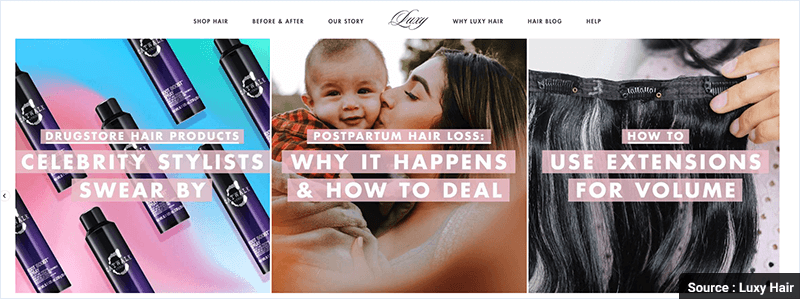
The online space is full of fierce competition, and eCommerce stores that keep exploring unique and creative ways to connect with their target markets turn out to be the actual winners.
2. User-Generated Content
Grasping the fleeting attention of prospects is a difficult job in this over-crowded nest of the eCommerce market.
With millions of content published on a daily basis, potential buyers rely more on user-generated content as experience and opinions of previous buyers are more trustworthy.
Leveraging UGC helps the prospects in making a hassle-free buying decision, and at the same time, it helps eCommerce vendors to interact with their target audience and improve their store conversion rate.
An eCommerce jewelry store named as KaleValaJewelry has a dedicated page on its website where it features the best Instagram story images of its clients wearing the brand’s jewelry.
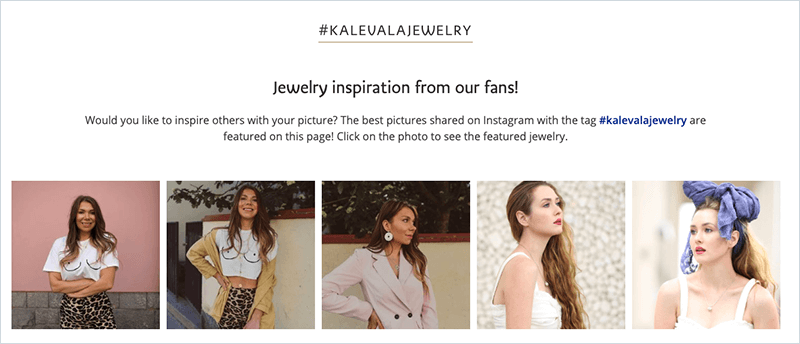
Once the user clicks on an image, window pop-ups where the existing client is wearing a piece of jewelry sold by the store, and at the same time, the viewer sees the original product image along with a buy now option.
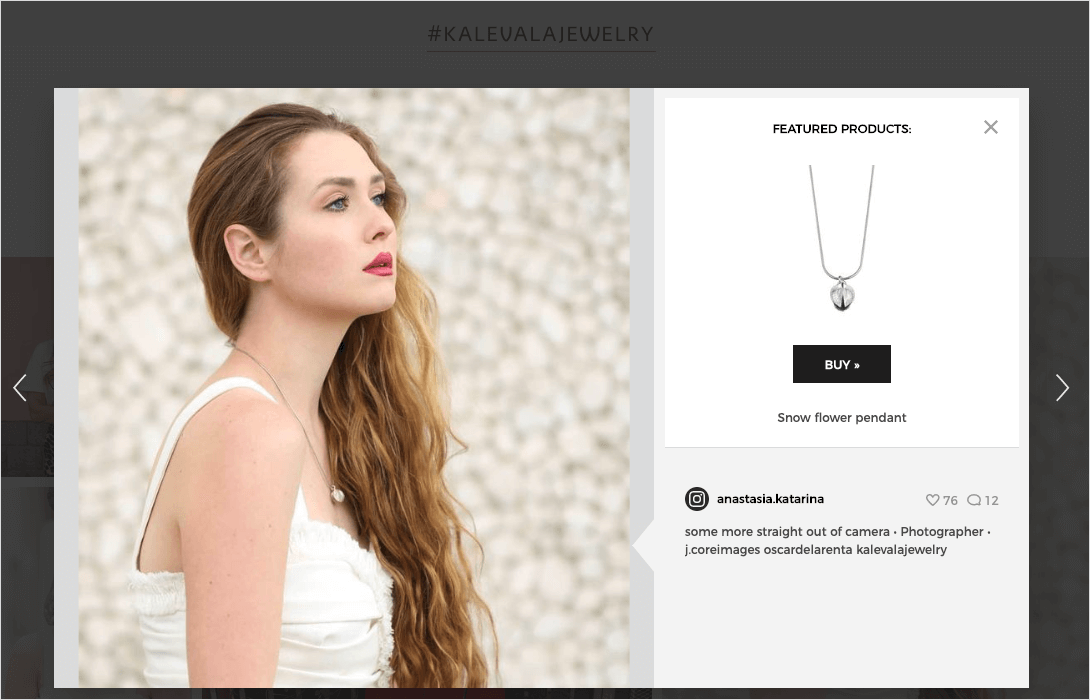
This image is a form of UGC, and the happy client image is a clear pictorial testimonial which speaks louder than words. Such creative forms of UGC vouch for the product and lure the buyers for making instant purchases.
Other most common types of user-generated content through which eCommerce marketers ‘must’ nurture their eStore are:
- Blog Comments
- Product Reviews
- User-generated blog posts
- Forums
- Question and Answers
3. Storytelling and Use-Cases Content
Ecommerce is all about virtual selling, and in such scenario, online buyers and shoppers get quickly connected with the stores if they encounter brand stories and real-life examples.
By sharing experiences, the sellers are able to build healthy relationships and grow the emotional bond with their prospects and buyers. Such efforts result in strengthening brand recall, and at the time of shopping, buyers will prefer your offerings in their buying decision.
An eCommerce company AWAY, which sells travel suitcases, believes in stories and that's why they have a dedicated page which describes their brand.

Away has also released a dedicated magazine called HERE through which it post stories for the travelers and also feature stories and use-cases shared by the travelers.

Effective Storytelling Strategies for Smart eCommerce stores:
- Connect with emotions.
- Include a problem-solving approach.
- Make the story sharable.
- Promote social cause related to your product offerings.
- Give customers a platform to share their stories.
4. Product Page Content
Product page design of an eCommerce website magnifies the website traffic and its conversion rates, as for every eStore, the product category content is imperative.
Marketers also agree to the fact that prospects undoubtedly make prompt buying decisions by referring to ecommerce pages that have advanced product information.
Must-Have Content on eCommerce Store’s Product Pages
- Optimized product titles and add detailed product specifications
- Correct product price
- Past customer reviews and ratings
- Question answers and detailed information regarding product
- delivery and return
- A clear CTA button
- Clear & multiple (from different angles) product images
Attractive product images entice the buyers, and thus, marketers limit the written text content and smartly position it on the page.
Below is a product page example of a brand called Fizki, which has flawlessly placed all the required details like explicit product image, price, specification, delivery information, and return policy.
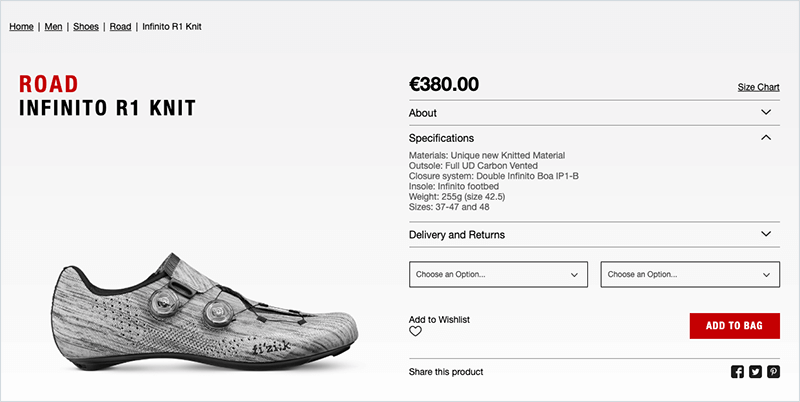
Along with all the above information, it also has a section for related products and client images wherein they are using the product.
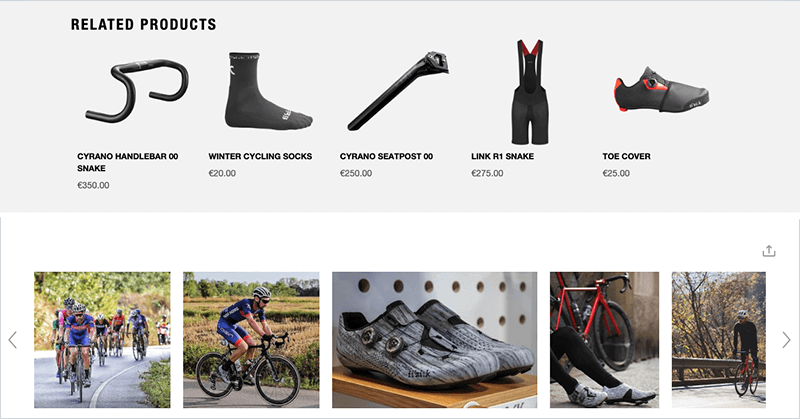
Social Media Marketing
Social media platforms have inspired the entire behavior of shoppers.
In this social era, marketers have testified that the combination of social media and web shopping opens ups several opportunities for ecommerce merchants.
Now for buying a product online, visiting an eStore is not the only option; instead, shoppers have an alternative to it - ‘Social Shopping.’
Thus, it is essential for eCommerce store owners to comprehend social media as a part of their marketing mix.
Why is it Must for Ecommerce Brands to Focus on their Social Media Presence?
Social media marketing is a versatile and cost-effective approach, and that is why it encourages small-scale businesses to incorporate their strategies deeply.
98.55% of social media audiences open at least 4 accounts a day and spend a lot of time scrolling various posts.
With such a massive chunk of active users, marketers affirm that social platforms imitate as a magnificent opportunity to reach their target audience.
Social Media Marketing Benefits:
- Boosts engagement metrics.
- Helps creatively promote entire product catalogs.
- Amplifies the brand’s presence.
- Different social platforms to reach a selective target audience.
- Helps in word of mouth publicity due to product review options.
- It allows gaining customers’ insights and quickly resolves their grievances.
Top Social Media Marketing Tactics Practiced by eCommerce Stores
1. Video Marketing
The emergence of video marketing has settled eCommerce stores’ one of the biggest stumbling blocks - ‘Engagement.’
Videos on social media have reshaped the way in which customers interact with a brand.
Today videos are so powerful that they not only grab the viewer's attention but smartly make them absorb the entire product information.
This drive steers the audience to the next level of their buying cycle, resulting in higher conversion rates.
Ecommerce brands now mark their presence by designing interactive videos and upload them on social platforms like YouTube, Facebook, and LinkedIn.
Rahul Saini, a survey participant, and veteran Content Marketer at Grazitti Interactive articulate
I believe that video marketing should be your go-to move in 2019. It is a great way to boost traffic and improve the conversion rate of your eCommerce store as videos are the best way to evoke an emotional response from the users. A video that resonates with the user at an emotional level is likely to stay in their subconscious and have a strong impression when they make a purchase decision.
A Brand’s Instagram Video Post Recorded 519K+ views:

Most Performing Types of Videos that Ecommerce Brands Must Create:
- Product tutorial videos including How-To guides
- Animated Videos
- Client Reviews and testimonial videos
- Promotional Videos
- Product Unboxing videos
- Live streaming videos
2. Real-Time Marketing
Real-Time Marketing (RTM) is an out-of-the-box moment where the brands spontaneously react to any local, national, or global events.
The aim is to connect with the audience using some current trends to boost engagement on social media platforms.
Take a look at how a famous toy production company - LEGO congratulated Marvel Studios for the success of their latest movie ‘Avengers EndGame.’
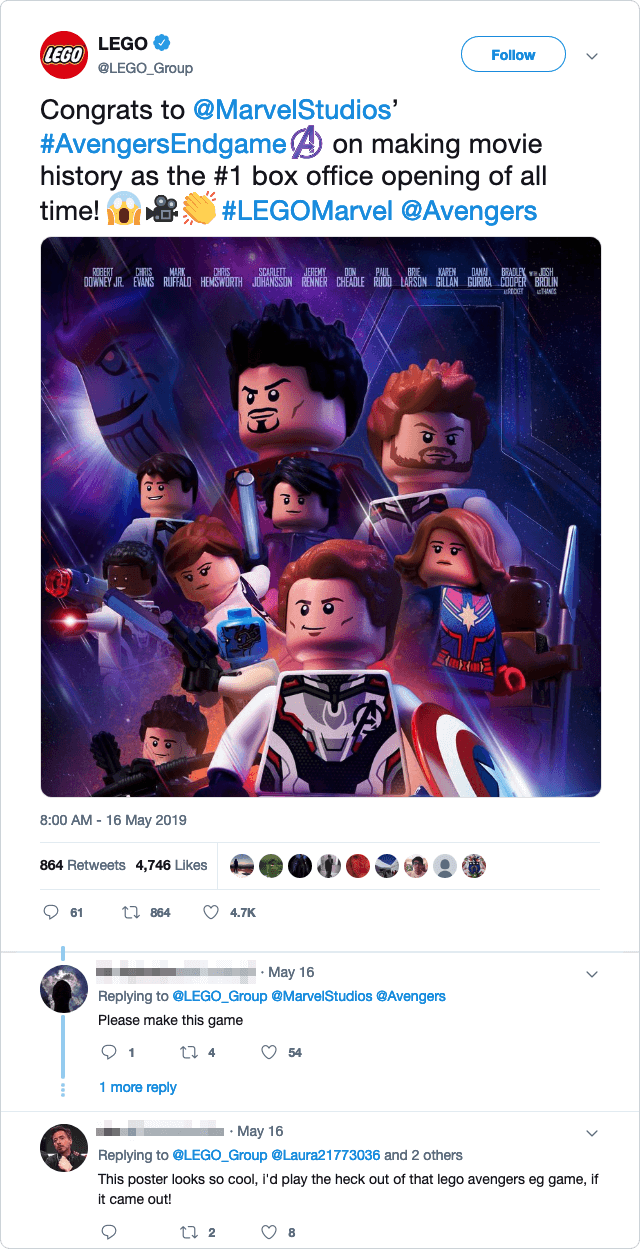
By posting on trending topics with relevant hashtags, eCommerce businesses aptly multiply their reach and promote the brands without sounding too salesy.
These posts are basically designed using the customer-centric approach, and marketers ensure posting them on precise time using the right social media platform.
Marketers vouch that RTM will not only bring leads to a brand, but it is highly effective in boosting the overall identity of a brand, including awareness and recall.
Real-Time Marketing Strategies - How can Ecommerce Brands do it Right
- Stay wide-awake with the current and forthcoming events.
- Employ expert designers and content strategists to deliver compelling visual message inlined with the current event to ensure a lasting effect.
- Be spontaneous.
3. Influencer Marketing
Several ecommerce businesses are investing heavily in advertisements, and still, they are unable to reap out maximum benefits.
One of the prime reasons for this issue is that a large chunk of eCommerce companies keep on dumping their ads to the consumers.
However, when faced with loads of ads, users are distracted and fail to come to a conclusion.
Thus, to overcome the issue, ecommerce agencies have found a middle way out wherein they pick an influencer who promotes their products without making it look like a sales pitch.
Influencer marketing is productive as buyers prefer to buy things that are vouched by some trusted and renowned name. For instance:

Even Yigit Kocak, Inbound Marketing Manager at Prisync, corroborate for exercising influencer marketing. He quotes
What I've seen the most effective strategy was SMM + Influencer marketing that generated the highest number of sales. Because trust is a very important driving factor for e-commerce businesses and with the help of authoritative bloggers and SMM buzz, we had an ROI of around 20x with that combination.
Top Influencer Marketing Strategies - How can eCommerce Stores Do it Right
- Look for the relevant influencer who can justify with the product your eStore sells.
- Pick the right platform depending upon where your target audience spends maximum time
- Craft a compelling message
- Post videos wherein influencers are vouching for your products/services
- Invariably track the results and try A/B testing with both the influencers as well as the ad content
4. Live Chat for Customer Support
Live Chat support on your social media business page works as a lifesaver for your customers.
It is one of the most effective touchpoints which helps the consumers in reaching out to a brand at any point in time.
It is a reasonable observation that users spend most of their time on social media compared to any brand’s eCommerce website.
Thus, social media allows eCommerce businesses to connect with prospects conveniently.
Be it for any product information, suggestions, or even for resolving any grievances; social media’s live chat option open ups opportunity for elevating sound client-business communication.
Plus, the chatbot market is expected to reach $102 billion by 2026, compared to $17 billion in 2020.
Take a leaf out of the retail brand, Sam’s Club that replies to its customers within an hour; one of the main reasons why millions are following the brand on Facebook:
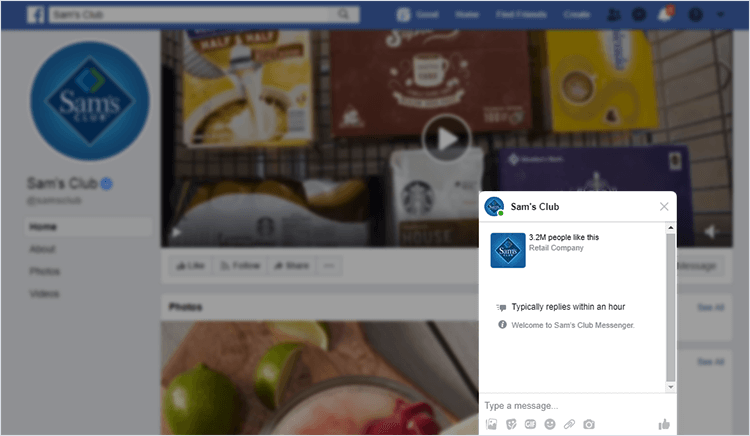
Remember! Those ecommerce companies who overlook Social Listening witnesses bleeding out a large chunk of loyal customers, because it gives them a notion that your brand is not listening to them.
Live Chat Strategies - How can eCommerce Stores do it Right
- Make sure you reply in real-time to customers/prospects
- Ensure you offer a smooth communication experience to your visitors
Email Marketing
Small eCommerce business entrepreneurs have shown positive notions for incorporating email marketing as it is a powerful digital channel used to reach the relevant audience with a personalized touch.
Emails, when framed correctly, convert prospects into buyers.
From sending personalized newsletters to winning the clients via lucrative discount offers, email marketing has been proved to be a modest marketing weapon for eCommerce stores.
Why is it Imperative for eCommerce Ventures to Employ Email Marketing?
It is a proven fact that email marketing enhances ROI.
Also, as per a recent GoodFirms survey on email marketing, 96.88% of marketing managers use emails to strengthen their relations with the customers.
Another reason which determines email marketing highly operative is that it resolves the three biggest challenges of eCommerce vendors - lead acquisition, conversion, and retention.
Thus, it is imperative for the marketers to incorporate different variants of email to reach out prospects belonging from all three stages of the sales funnel.
Ellie-Paige Moore, Marketing Manager at Blinds Direct, shared her experience of leveraging email marketing -
Email is a valuable marketing approach for our company, especially for boosting sales. Many of our competitors don’t use email marketing to their advantage, but throughout the years, we’ve managed to fine-tune our emails and create excellent content. We send around 3-4 emails per week, and the content differs in each. If we are holding a sale, one email will definitely be based on this topic. The remaining emails would focus on new products, bestsellers, and current trends. While the latter doesn’t necessarily increase sales, they always drive traffic to the site. Emails are also a great opportunity to run loyalty and reward campaigns; in recent months, we’ve seen a marked improvement in customer acquisitions by rewarding the loyal customer who has referred a friend.
Such gratifying outcomes make emails a compelling marketing toolkit for marketers.
Types of Email Marketing Campaigns
1. Transactional Email
Ecommerce marketers basically use transactional emails to nurture prospects belonging from the top-of-the-funnel sales cycle.
Such emails include messages like onboarding new subscribers, order confirmation, invoice receipts, shipping updates, return updates, customer feedback forms, and any other kind of notification or information.
Mytheresa, an ecommerce store, sends an enticing welcoming email to every new subscriber.

These kinds of emails have maximum open rates as they are perfectly personalized and possess valuable information.
Benefits of Sending Transactional Emails
- Receiving personalized emails makes users feel privileged.
- Transactional email triggers clients’ second purchases.
- Reduces the possibility of cart abandonment.
2. Lead Nurturing Email
In ecommerce business, lead nurturing turns out to be a quintessential email marketing strategy because, through these emails, a brand communicates with the potential buyers that have entered in their sales funnel.
Since the audience has already taken a plunge in your brand and signed-up for the newsletter, it is an opportunity to understand their buying desires and engage them with the brand via lead nurturing emails.
Now escalating these selective target audiences from point A to B depends upon the strategies employed by email marketers.
To nurture maximum leads, 7wData inform its subscribers about an upcoming event via lead nurturing email.

Benefits of Sending Lead Nurturing Emails
- Turns prospects into sure-shot buyers.
- Increases brand awareness and encourages product branding.
- Smoothens the trust-building process.
3. Promotional Email
Promotional emails are designed for the mass audience, and the objective is to make the visitors aware of the enticing offers and discounts.
Discount emails, when designed strategically, have immense potential to draw the attention of the audience.
Professional marketers make use of promotional emails for spreading new product release information, product newsletters, discount offers, time-sensitive deals on occasions like Black Friday and Cyber Monday, and any other announcements related to any freebies offered by the ecommerce store.
Also, such emails result in higher CTR when marketers target the audience based on gender, demographics, past email engagement, and the user’s previous buying patterns.
Like a personalized gift, eStore uses every possible occasion to reach out to its clients by sending them promotional emails. In the below example, the brand reaches out to its clients on the occasion of Father’s Day.

Ecommerce marketing managers also design dynamic promotional email campaigns for cross-selling and upselling their products to the existing clients.
Benefits of Sending Promotional Email
- Generates higher leads when brands offer exclusive discounts to customers.
- Effective for chasing clients on special occasions by seasonal theme offers.
- Promotes brand.
4. Cart Abandonment Email
Cart abandonment is a major concern for eCommerce stores as it amplifies the proportion of unrealized revenue.
That is why ecommerce marketing experts closely monitor email campaigns for the abandoned cart.
These kinds of emails are a gentle reminder to the clients recalling them about finishing the final stage of their buying cycle.
Also, sending cart abandoned emails work in the direction of converting skeptical buyers into sure-shot customers.
Nowadays, to capture the attention of dropped shoppers, marketers have found a new way of sending emails, including video thumbnail images which redirect the users on product landing pages. The email will have video content with persuasive call-to-action buttons.
To recover the lost sales, an eStore sends a personalized reminder email to its prospect so that s/he can quickly finish the final stage of shopping.
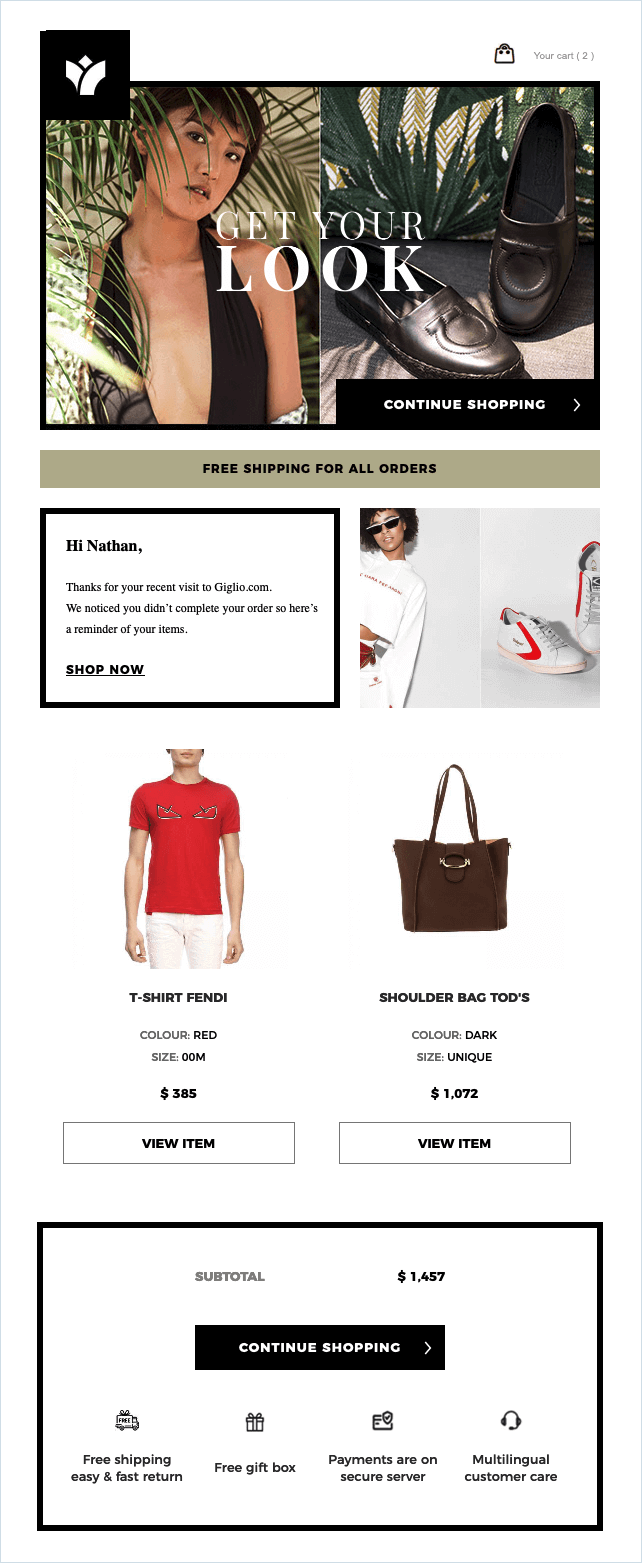
Benefits of Sending Cart Abandonment Emails
- Establish brand relations as sending personalized messages make the buyers feel special.
- Gives a smart way to remarket products which the prospect is actually interested in buying.
5. Remarketing Email
Ecommerce store leaders chase the lost opportunity by reaching out to the visitors who visited the store for a very short span of time and didn't route back.
Marketers collect the customers’ information via the browser cookies and send these audiences real-time promotional emails so that they can revisit the store and turn into buyers.
Retargeting emails are also helpful in nurturing the existing clients by sending them emails for cross-selling and upselling.
Grammarly’s Remarketing Email Uses Urgency Tactics to bring back the bounced audience.
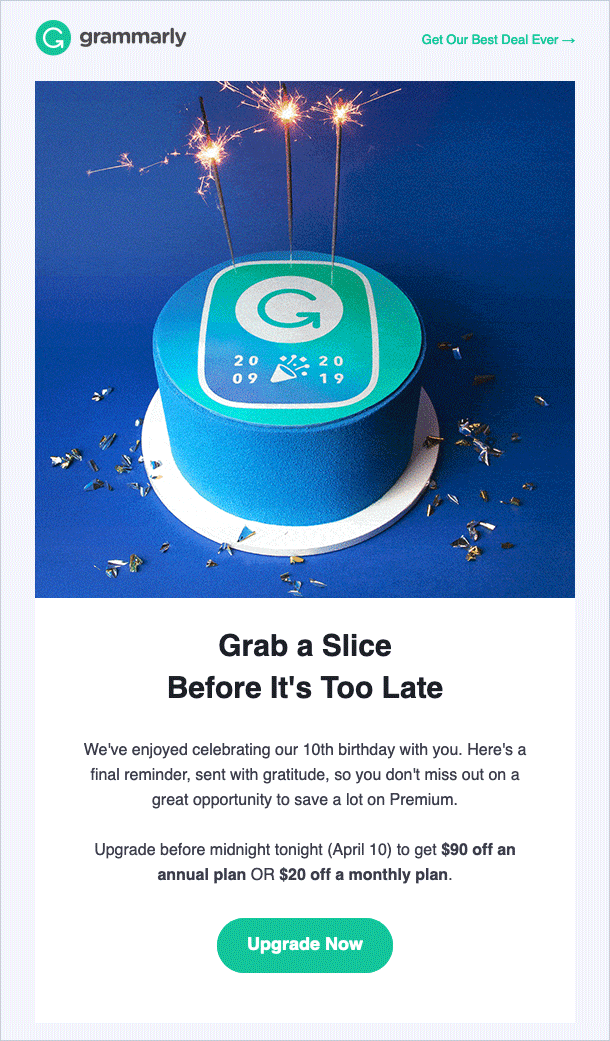
Moreover, these emails are also conducive in stimulating the receivers’ buying motives by offering them discounts to take immediate shopping decisions.
Benefits of Sending Remarketing Emails
- Evoke the buyers to revisit the eStore and finish the aspired shopping.
- Supports brand recall.
- Cost-effective way to broadcast promotional offers and tailoring messages to eStore visitors.
Conclusion
E-Commerce is one of the fastest-growing industries where competition is severe.
Every eStore is competing with millions of other vendors but only those entrepreneurs can beat the competition who keep on implementing modest strategies.
In the stringent market, one must seek directions from the industry experts, fellow ecommerce business people, and incorporate the strategies as mentioned earlier and tactics to win the ultimate battle called ‘Profits.’
Take the channels mentioned above and tactics outlined by the ecommerce experts; and introduce them into your marketing mix so that you can maximize ecommerce sales, promote your brand, and grow the numbers of contented customers.
For achieving exceptional results, you can reach out to the top digital marketing companies listed by GoodFirms. These companies have sheer experience in leveling up your eCommerce revenues.
As a growing ecommerce agency, which ecommerce marketing strategy results in higher conversions for your store? We would like to hear back from you, mention your experiences in the comment section below.



